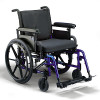Invacare PATRIOT Owners Manual - Page 21
Safety Inspection, Troubleshooting
 |
View all Invacare PATRIOT manuals
Add to My Manuals
Save this manual to your list of manuals |
Page 21 highlights
SECTION 3-SAFETY INSPECTION/TROUBLESHOOTING SECTION 3-SAFETY INSPECTION/ TROUBLESHOOTING NOTE: Twice a year, take your wheelchair to a qualified dealer for a thorough inspection and servicing. Regular cleaning will reveal loose or worn parts and enhance the smooth operation of your wheelchair. To operate properly and safely, your wheelchair must be cared for just like any other vehicle. Routine maintenance will extend the life and efficiency of your wheelchair. Initially and at least every six months, follow these maintenance procedures: SAFETY INSPECTION CHECKLISTS Initial adjustments should be made to suit the personal body structure needs and preferences of the user. Thereafter follow these maintenance procedures: INSPECT/ADJUST INITIALLY ❑ Wheelchair rolls straight (no excessive drag or pull to one side). ❑ Ensure all hardware is tight. ❑ No bent or protruding metal on clothing guards. ❑ All fasteners on clothing guards are secure. ❑ Arms are secure but easy to release and adjustment levers engage properly. ❑ Adjustable height arms operate and lock securely. ❑ Armrest pad sits flush against arm tube. ❑ Seat and/or back upholstery have no rips. ❑ Inspect adjustable angle back attaching hardware is securely tightened. ❑ Ensure hand grips are not loose. ❑ Sealed bearings and axle nut tension are correct. ❑ No excessive side movement or binding when rear wheels are lifted and spun. ❑ Quick‐release axles lock properly. ❑ Inspect handrims for signs of rough edges or peeling finish. ❑ Inspect for broken spokes. ❑ Wheel/fork assembly has proper tension when caster is spun. Caster should come to a gradual stop. CAUTION As with any vehicle, the wheels/casters and tires should be checked periodically for cracks, flat spots and wear, and should be replaced. ❑ Loosen/tighten locknut if wheel wobbles noticeably or binds to a stop. Part No 1088909 21 Patriot™
-
 1
1 -
 2
2 -
 3
3 -
 4
4 -
 5
5 -
 6
6 -
 7
7 -
 8
8 -
 9
9 -
 10
10 -
 11
11 -
 12
12 -
 13
13 -
 14
14 -
 15
15 -
 16
16 -
 17
17 -
 18
18 -
 19
19 -
 20
20 -
 21
21 -
 22
22 -
 23
23 -
 24
24 -
 25
25 -
 26
26 -
 27
27 -
 28
28 -
 29
29 -
 30
30 -
 31
31 -
 32
32 -
 33
33 -
 34
34 -
 35
35 -
 36
36 -
 37
37 -
 38
38 -
 39
39 -
 40
40 -
 41
41 -
 42
42 -
 43
43 -
 44
44 -
 45
45 -
 46
46 -
 47
47 -
 48
48 -
 49
49 -
 50
50 -
 51
51 -
 52
52 -
 53
53 -
 54
54 -
 55
55 -
 56
56 -
 57
57 -
 58
58 -
 59
59 -
 60
60 -
 61
61 -
 62
62 -
 63
63 -
 64
64 -
 65
65 -
 66
66 -
 67
67 -
 68
68 -
 69
69 -
 70
70 -
 71
71 -
 72
72 -
 73
73 -
 74
74 -
 75
75 -
 76
76 -
 77
77 -
 78
78 -
 79
79 -
 80
80 -
 81
81 -
 82
82 -
 83
83 -
 84
84 -
 85
85 -
 86
86 -
 87
87 -
 88
88 -
 89
89 -
 90
90 -
 91
91 -
 92
92 -
 93
93 -
 94
94 -
 95
95 -
 96
96 -
 97
97 -
 98
98 -
 99
99 -
 100
100 -
 101
101 -
 102
102 -
 103
103 -
 104
104 -
 105
105 -
 106
106 -
 107
107 -
 108
108
 |
 |

